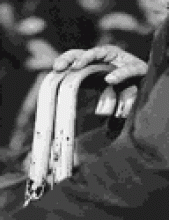In a recent CMAJ commentary, Schabas1 argues that the time has come for colorectal cancer screening in Canada using fecal occult blood (FOB) testing. He points out that, based on the available evidence, 6 Canadian groups have endorsed annual or biennial FOB screening of average-risk, asymptomatic people 50 years of age and older. He also points out that colonoscopy is an option for screening, that it is “probably a better screening tool than FOB testing” but that we do not have the capacity to offer colonoscopy as the initial screening test.
Although we agree that colonoscopy is better than FOB testing in detecting colorectal cancer and share Schabas' concern about the capacity of our health care system to offer colonoscopy as the initial screening test, flexible sigmoidoscopy, endorsed by the Canadian Task Force on Preventive Health Care as an alternative to FOB testing,2 offers another approach.
Case–control studies have shown a reduction of 60% to 80% in the rate of death from rectosigmoid cancer using screening sigmoidoscopy, with a protective effect lasting up to 10 years.3 The detection rates of cancer (0.3%) and adenomas (12%) among the 40 674 individuals enrolled in the UK Flexible Sigmoidoscopy Screening Trial4 exceeded those reported in the initial screening round of a large randomized controlled trial of FOB testing (0.2% and 0.8% respectively).5 Also, the rate of detection of adenomas 1 cm or greater in size in the UK Flexible Sigmoidoscopy Screening Trial was 4 times higher than the rate with one-time FOB screening. Lieberman and Weiss6 performed colonoscopy in a cohort of 3121 asymptomatic adults aged 50–75 years. Colorectal cancer was detected in 1%, and advanced neoplasms (adenomas 1 cm or larger, villous adenomas and adenomas with high-grade dysplasia) were detected in 9.6%. They estimated that one-time FOB screening would detect 24% of patients with colorectal cancer or advanced neoplasms and that flexible sigmoidoscopy would detect 70%, provided that all individuals with an adenoma in the distal colon undergo colonoscopy. In addition, they estimated that one-time combined screening with FOB testing and sigmoidoscopy would detect 76% of cases of colorectal cancer or advanced neoplasms.
There is strong evidence that trained nurses can perform flexible sigmoidoscopy as safely and effectively as physicians. In one study, 2 registered nurses and 2 licensed practical nurses, trained to do flexible sigmoidoscopy, performed 1881 independent screening examinations of outpatients 45 years or older.7 During the same period, 730 examinations in similar outpatients were performed by 2 gastroenterologists. The mean depth of insertion of the sigmoidoscope was slightly greater (by 2–3 cm) in the patients examined by the physicians, the proportion of examinations that were positive for adenomas or cancer did not differ between the nurse and physician groups, and there were no complications. In another study of flexible sigmoidoscopy in asymptomatic people 50 years and older with no family history of colorectal cancer,8 nurse practitioners and physician assistants detected neoplastic polyps in a greater proportion of patients than did physicians (7.8% v. 5.8%); however, this difference was not significant after adjustment for differences in patient age and sex. No complications occurred. In a subsequent randomized controlled trial, 328 patients were assigned to screening flexible sigmoidoscopy (with a 70-cm instrument) by either a nurse endoscopist or a gastroenterologist.9 The rate of missed adenomatous polyps did not differ significantly between the 2 groups (21% and 20% respectively, p = 0.91), and no complications occurred. The gastroenterologists inserted the sigmoidoscope further than the nurse endoscopists did (61 v. 55 cm, p < 0.001).
What would the advantages be of establishing programs in Canada whereby colorectal cancer screening with flexible sigmoidoscopy would be performed by nurses? Clearly, flexible sigmoidoscopy has rates of detecting cancer and adenomas that compare favourably with those for FOB testing. Flexible sigmoidoscopy is effective and safer than colonoscopy (perforation rate 1 per 10 000 v. 1 per 1000),10 bowel preparation is easier (an enema 2–3 hours before the procedure), and because conscious sedation and patient monitoring are not needed with flexible sigmoidoscopy, the procedure can be readily done in an office setting. Finally, access to the procedure need not be limited in rural areas. In many northern regions of the country, nurse practitioners already play a key role in the delivery of primary care.
A model of screening using flexible sigmoidoscopy performed by a trained nurse has been reported in Ontario.11 During each half-day clinic, the nurse used a video-monitored flexible sigmoidoscope to examine 10 average-risk patients. The videos were later reviewed by a gastroenterologist. About 15% of the patients were referred for subsequent colonoscopy.
In the future, other options will likely be available for colorectal cancer screening, such as CT colonography. Although a few studies have shown this technique to have a sensitivity of at least 90% for polyps 1 cm or greater in size,12 other studies have not.13 The explanation for these mixed results is not yet clear. Although promising and deserving of further study, CT colonography is not ready for use in clinical practice as a colorectal cancer screening test.
The need for population-based colorectal cancer screening programs in Canada is urgent. As an alternative method to FOB screening, let us consider flexible sigmoidoscopy done by nurse endoscopists. It would be effective and could be done safely and efficiently in an office setting. We propose that a national task force examine the feasibility of implementing screening programs with flexible sigmoidoscopy performed by nurse endoscopists. The burden of colorectal cancer in Canada is among the highest in the world. How can we justify further delay?
Footnotes
-
Contributors: Dr. Rabeneck was responsible for drafting the article. Both authors were responsible for the critical revision of the article for intellectual content and for approving the final version.
Competing interests: None declared.








